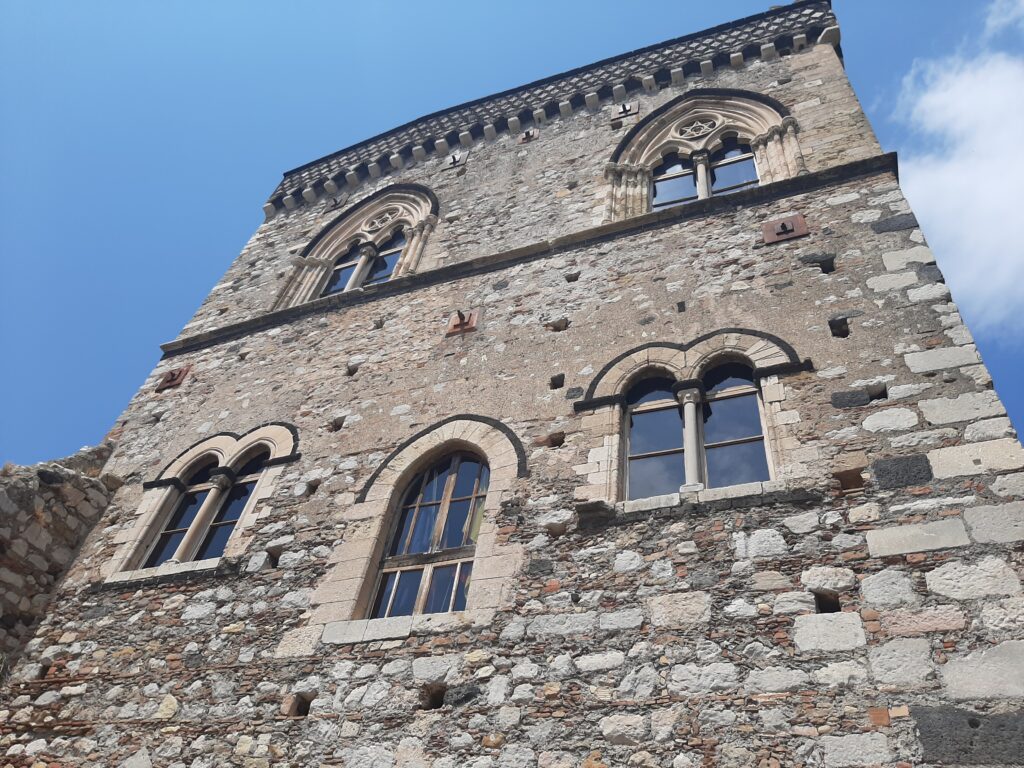Nel cuore di Taormina, just a few steps from Porta Catania, stands one of the most fascinating and lesser-known buildings of the city: the Palazzo di Santo Stefano, also known as the Palazzo dei Duchi di Santo Stefano. This architectural jewel, set within the medieval fabric of the town, tells centuries of Sicilian history, between Norman, Gothic, and Arab influences, and today opens to the public as a vibrant cultural space.
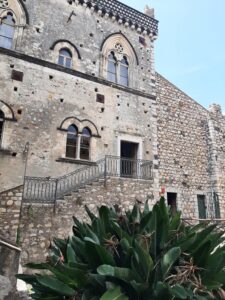 A Palace Born for Nobility
A Palace Born for Nobility
The construction of the Palazzo di Santo Stefano dates back to the late 14th century, when the noble De Spuches family, of Spanish origin, decided to settle in Taormina. The De Spuches were Dukes of Santo Stefano di Briga and Princes of Galati, and the palace was conceived as a noble residence, but also as a symbol of power and prestige. Its strategic location, integrated into the city walls, suggests a defensive as well as residential function.
The building stands out for its massive, square structure, built in lava stone and decorated with inserts of white stone from Syracuse. The Gothic mullioned windows, trilobed decorations, and perforated rose windows bear witness to the skill of the craftsmen of the time and the wealth of the commissioning family. The garden, which develops on sloping ground, still preserves an ancient well for collecting rainwater, a typical element of Sicilian noble residences.
Who Lived in the Palace
For centuries, the Palace was inhabited by the descendants of the De Spuches family, who preserved its identity and original style. The last member of the family to own it was Vincenzo De Spuches, who ceded it to the Municipality of Taormina in 1964. Since then, the Palace has changed function, transforming from a private residence into a public space dedicated to art and culture.
How to Reach the Palazzo di Santo Stefano
The Palace is located in the historic center of Taormina, easily reachable on foot from Corso Umberto. Those arriving by car can park near Porta Catania and continue on foot for a few minutes. Its central position makes it an ideal stop for those visiting the city, perhaps after a stroll among artisan shops or a visit to the Cathedral.
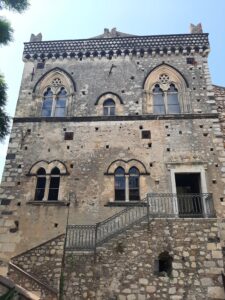 A Place for Art: The Mazzullo Foundation
A Place for Art: The Mazzullo Foundation
Today the Palazzo di Santo Stefano hosts the Giuseppe Mazzullo Foundation, dedicated to the Sicilian artist born in Graniti in 1913. His works, sculptures and drawings, are exhibited across the three floors of the Palace and in the garden, creating a fascinating dialogue between contemporary art and historic architecture. During the summer, the garden becomes a stage for cultural events, concerts, temporary exhibitions, and artist meetings, making the Palace a cultural landmark of Taormina.
The Origins: The De Spuches Family
The Palace was built at the end of the 14th century by the De Spuches family, a noble house of Catalan origin, which arrived in Sicily during the 13th century. The De Spuches distinguished themselves for their political and cultural role on the island, accumulating titles and fiefs that made them one of the most influential families of the Kingdom of Sicily. Among their most prestigious titles: Dukes of Santo Stefano di Briga, Princes of Galati, Marquises of Schisò, Barons of Calamonaci, and Dukes of Caccamo.
The title of Duke of Santo Stefano di Briga was linked to a locality near Messina, while that of Prince of Galati referred to Galati Mamertino, a mountain village in the Nebrodi. These titles were not just symbols of prestige but represented real power, exercised through the management of lands, castles, and communities.
The Palace: Architecture and Function
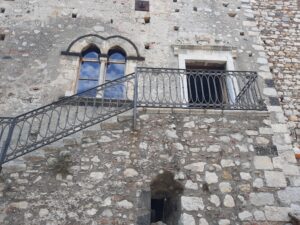 Built in lava stone and decorated with inserts of white stone from Syracuse, the Palazzo di Santo Stefano is an extraordinary example of Sicilian Gothic architecture with Arab influences. Its square and compact structure, trilobed mullioned windows, perforated rose windows, and hanging garden with medieval well tell of a residence designed for nobility, but also for defense.
Built in lava stone and decorated with inserts of white stone from Syracuse, the Palazzo di Santo Stefano is an extraordinary example of Sicilian Gothic architecture with Arab influences. Its square and compact structure, trilobed mullioned windows, perforated rose windows, and hanging garden with medieval well tell of a residence designed for nobility, but also for defense.
For centuries, the Palace was inhabited by the descendants of the De Spuches, who preserved its identity and original style. Among the most illustrious members of the family stands out Francesco San Martino De Spuches, historian and senator of the Kingdom, author of a monumental work on Sicilian genealogy and fiefs. His erudition helped preserve the historical memory of the island’s nobility.
The Link with Taormina
The De Spuches family not only lived in Taormina but also actively contributed to its cultural enhancement. In the 18th century, Biagio De Spuches, Duke of Santo Stefano, was among the first to promote archaeological excavations at the Greek Theatre. A great collector, he gathered ancient coins and statues, some of which were displayed in his residences, including the Castle of Villagonia, now disappeared, demolished to make way for the Giardini Naxos railway station.
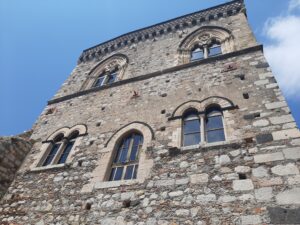 The long stay of the De Spuches family in the Palazzo di Santo Stefano ended in 1964, when the last descendant, Vincenzo De Spuches, officially ceded the property to the Municipality of Taormina. Vincenzo, by then residing in Palermo, represented the last generation directly linked to that historic residence. With the sale, a centuries-old chapter came to a close, one that had seen the palace as the center of Taormina’s noble life.
The long stay of the De Spuches family in the Palazzo di Santo Stefano ended in 1964, when the last descendant, Vincenzo De Spuches, officially ceded the property to the Municipality of Taormina. Vincenzo, by then residing in Palermo, represented the last generation directly linked to that historic residence. With the sale, a centuries-old chapter came to a close, one that had seen the palace as the center of Taormina’s noble life.
The decision to leave the palace was not only a practical choice but also a symbolic one: it marked the transition from a private aristocratic residence to a public asset dedicated to culture. The Municipality of Taormina purchased the building with the intent of preserving its historical and architectural value, and of transforming it into a space open to citizens and visitors.
From that moment, the Palazzo di Santo Stefano changed its role, while maintaining its soul intact. Today it hosts art exhibitions, cultural events, and initiatives that celebrate the history and beauty of Taormina. The ancient rooms, once inhabited by nobles and intellectuals, have become meeting and inspiration places for artists and visitors from all over the world.
Farewell to the Palace: Why Vincenzo De Spuches Left Santo Stefano
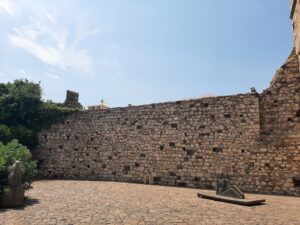 In the heart of Taormina, the Palazzo di Santo Stefano represented for centuries the symbol of Sicilian nobility. Home of the De Spuches family, the palace was more than a residence: it was a place of power, culture, and memory. However, in 1964, Vincenzo De Spuches, the last direct descendant of the house, decided to transfer ownership to the Municipality of Taormina. A gesture that marked the end of an era and the beginning of a new destiny for the building.
In the heart of Taormina, the Palazzo di Santo Stefano represented for centuries the symbol of Sicilian nobility. Home of the De Spuches family, the palace was more than a residence: it was a place of power, culture, and memory. However, in 1964, Vincenzo De Spuches, the last direct descendant of the house, decided to transfer ownership to the Municipality of Taormina. A gesture that marked the end of an era and the beginning of a new destiny for the building.
A Choice Dictated by Time
The decision to leave the palace was not sudden. In the post-war years, many Sicilian aristocratic families faced a rapidly changing world. Noble prestige was no longer enough to sustain the costs of maintaining historic buildings, often in need of expensive restoration and complex management. Vincenzo, who lived permanently in Palermo, realized that the palace no longer had a role in his daily life.
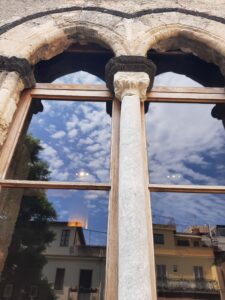 The Weight of Responsibility
The Weight of Responsibility
Beyond the economic aspects, there was also a deeper reflection: the palace, emptied of its family function, risked becoming a silent monument, closed to the world. Vincenzo understood that, to preserve its beauty and history, it was necessary to entrust it to those who could enhance it. The Municipality of Taormina showed interest in transforming it into a public space, dedicated to culture and art.
A Gesture of Openness
The transfer of the Palazzo di Santo Stefano was therefore an act of generosity and foresight. Vincenzo De Spuches did not renounce the past but entrusted it to the community, so that it could continue to live in a new form. Since then, the palace has become home to exhibitions, events, and cultural initiatives, keeping its historic soul intact.
The Meaning of a Farewell
Leaving the palace did not mean abandoning memory, but transforming it. With his gesture, Vincenzo De Spuches allowed his family’s history to intertwine with that of the city, opening the doors of a private place to the community. A farewell that, in the end, was also a new beginning.

